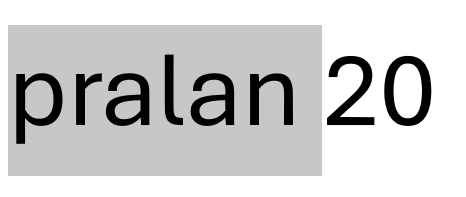Pralan 20 contains the active ingredient Pantoprazole, belonging to a class of medications called proton pump inhibitors (PPIs). It’s used to treat acid-related conditions by reducing the amount of acid produced in the stomach.
What is Pralan 20?
Pralan 20 is a medication that contains Pantoprazole as its active ingredient. It’s a gastro-resistant tablet, usually prescribed in the strength of 20mg. Pantoprazole is a proton pump inhibitor (PPI) used to reduce the production of stomach acid.
This medication is commonly prescribed to treat conditions such as gastroesophageal reflux disease (GERD), where stomach acid flows back into the esophagus, causing heartburn and irritation. It’s also used to manage peptic ulcers, which are open sores in the lining of the stomach or the small intestine, often caused by excessive acid production.
Pralan 20 (Pantoprazole) works by inhibiting the action of proton pumps in the stomach lining, thereby reducing the amount of acid produced. This reduction in acid helps alleviate symptoms associated with excess acidity and promotes the healing of ulcers in the stomach or intestines.
As with any medication, it’s essential to take Pralan 20 as prescribed by a healthcare professional and to follow their recommendations regarding dosage and duration of treatment. Also, discussing any concerns or potential side effects with a doctor is important to ensure safe and effective use.
How does Pralan 20 work to treat acid-related conditions?
Pralan 20, containing Pantoprazole as its active ingredient, belongs to a class of medications known as proton pump inhibitors (PPIs). It works by targeting and inhibiting the action of proton pumps in the stomach lining, specifically the H+/K+-ATPase enzyme system located in the gastric parietal cells.
Here’s a breakdown of how Pralan 20 (Pantoprazole) works to treat acid-related conditions:
- Inhibition of Proton Pumps: These pumps are responsible for producing stomach acid by releasing hydrogen ions into the stomach. Pantoprazole binds to the proton pumps, irreversibly inhibiting them. This action significantly reduces the production of gastric acid.
- Reduction in Acid Production: By hindering the action of proton pumps, Pantoprazole effectively decreases the secretion of gastric acid. As a result, the pH level in the stomach rises, reducing the acidity of the stomach contents.
- Relief from Acid-Related Symptoms: By lowering stomach acid levels, Pantoprazole helps alleviate symptoms associated with acid-related conditions such as gastroesophageal reflux disease (GERD), peptic ulcers, and related issues. It allows the esophagus or ulcerated areas to heal by reducing the corrosive effect of excess acid.
- Promotion of Healing: Lowering acid levels in the stomach facilitates the healing process of the esophagus in GERD or the lining of the stomach or small intestine in the case of peptic ulcers. This reduction in acid allows the affected areas to heal and minimizes the likelihood of recurrence.
Pralan 20 works more effectively when taken regularly as prescribed by a healthcare professional. However, it’s crucial to note that this medication might take some time to provide noticeable relief from symptoms, and the duration of treatment is determined by the underlying condition and the advice of a healthcare provider.
When to Use Pralan 20?
Pralan 20, containing Pantoprazole as its active ingredient, is typically prescribed in the following situations:
- Gastroesophageal Reflux Disease (GERD): Pralan 20 is commonly used to manage GERD, a condition where stomach acid backs up into the esophagus, leading to heartburn, chest pain, and irritation. It helps alleviate symptoms and promotes healing of the esophageal lining.
- Peptic Ulcers: This medication is often prescribed to treat peptic ulcers, which are open sores in the lining of the stomach or the upper part of the small intestine. Pralan 20 reduces stomach acid production, aiding in the healing of these ulcers and preventing their recurrence.
- Erosive Esophagitis: Pantoprazole in Pralan 20 can also be used to treat erosive esophagitis, a condition characterized by inflammation and damage to the esophagus due to stomach acid backing up into it.
- Zollinger-Ellison Syndrome: In cases of Zollinger-Ellison Syndrome, a rare condition causing excessive stomach acid production and ulcers, Pralan 20 may be prescribed to control acid secretion and manage symptoms.
- Prevention of NSAID-Induced Ulcers: For individuals who require long-term use of nonsteroidal anti-inflammatory drugs (NSAIDs) and are at risk of developing ulcers due to these medications, Pralan 20 might be prescribed to prevent NSAID-induced ulcers.
Remember, Pralan 20 should be used as directed by a healthcare professional. The dosage and duration of treatment can vary based on the specific condition being treated and individual health factors. It’s essential to follow the prescribed regimen and discuss any concerns or potential side effects with a doctor. Additionally, this medication may not be suitable for everyone, so it’s crucial to have a thorough discussion about its use based on individual health circumstances.
Dosage and Precautions
The typical dosage of Pralan 20 (Pantoprazole) can vary depending on the condition being treated. However, a common dosage for adults in treating conditions like GERD and peptic ulcers is usually around 20mg to be taken orally once a day.
Here are some general precautions to consider while taking Pralan 20:
- Follow Prescribed Dosage: Adhere strictly to the dosage prescribed by your healthcare provider. Do not increase or decrease the dose without consulting a doctor.
- Take as Directed: Pralan 20 is typically taken before a meal. Follow the instructions provided by your doctor or on the medication label.
- Duration of Use: The duration of treatment can vary. Finish the prescribed course even if symptoms improve before completion. Do not stop taking it abruptly without consulting your doctor.
- Medical History: Inform your healthcare provider about your medical history, especially if you have liver disease or any allergies to Pantoprazole or other medications.
- Interactions: Pantoprazole may interact with other medications. Inform your doctor about all medications, including over-the-counter drugs, supplements, or herbal remedies you’re taking.
- Pregnancy and Breastfeeding: Consult your doctor before using Pralan 20 if you are pregnant, planning to become pregnant, or breastfeeding.
- Side Effects: Be aware of potential side effects, including but not limited to headache, diarrhea, nausea, abdominal pain, and rash. Contact your healthcare provider if you experience severe or persistent side effects.
- Regular Check-ups: Periodic check-ups may be necessary to monitor your response to the medication and assess any potential side effects or changes in your condition.
Always consult with a healthcare professional for specific dosage instructions and precautions tailored to your individual health circumstances. These guidelines are general and may need adjustment based on your medical history and the advice of your healthcare provider.
You may want to read about: Gastropan 40mg.. Used For what in UAE?
Potential Side Effects
While Pantoprazole, the active ingredient in Pralan 20, is generally well-tolerated, like any medication, it can cause side effects in some individuals. Not everyone experiences these side effects, and they can vary in severity. Some potential side effects of Pralan 20 (Pantoprazole) may include:
- Common Side Effects:
- Headache
- Diarrhea
- Nausea
- Abdominal pain
- Flatulence (gas)
- Dizziness
- Less Common Side Effects:
- Vomiting
- Constipation
- Dry mouth
- Skin rash or itching
- Joint pain
- Rare but Serious Side Effects (Seek Immediate Medical Attention):
- Severe allergic reactions (rare but can be serious)
- Severe stomach pain
- Persistent diarrhea
- Unexplained weight loss
- Signs of low magnesium levels (such as seizures, muscle spasms, irregular heartbeat)
It’s essential to note that this list isn’t exhaustive, and individuals may experience side effects not mentioned here. Moreover, some side effects might require medical attention while others may subside as your body adjusts to the medication.
If you experience any severe or persistent side effects, it’s crucial to contact your healthcare provider immediately. Additionally, if you have any concerns about the side effects or are experiencing discomfort, it’s advisable to consult with your doctor.
For any unusual or severe reactions, seek emergency medical attention or contact your healthcare provider or local emergency services right away.
Frequently Asked Questions (FAQs)
Is Pralan 20 available in the UAE?
PRALAN 20mg is available in the market in concentration 20 mg/ tablet and in the form of Gastro-resistant tablet.
ANNORA PHARMA FZ-LLC is the producer of PRALAN 20mg and it is imported from UAE.
What are the side effects of Pantomed 20 mg?
Pantomed 20 mg contains Pantoprazole as its active ingredient, similar to Pralan 20 mg. Pantoprazole is a proton pump inhibitor used to reduce stomach acid production. The potential side effects of Pantomed 20 mg are generally similar to those associated with Pantoprazole-based medications like Pralan 20 mg.
Common side effects of Pantoprazole (Pantomed 20 mg) can include:
- Headache
- Nausea
- Diarrhea
- Abdominal pain
- Dizziness
- Vomiting
These side effects are usually mild and may improve as your body adjusts to the medication. However, if they persist or worsen, it’s important to inform your healthcare provider.
In some cases, more serious side effects might occur, although they are less common. These could include:
- Severe diarrhea: In rare instances, Pantoprazole may lead to Clostridium difficile-associated diarrhea, characterized by persistent or severe diarrhea.
- Allergic reactions: Symptoms may include rash, itching, swelling, severe dizziness, or trouble breathing. Seek immediate medical attention if you experience signs of an allergic reaction.
- Bone fractures: Long-term and high-dose use of PPIs like Pantoprazole may slightly increase the risk of bone fractures, particularly in older adults or those on prolonged therapy.
- Low magnesium levels: Prolonged use of PPIs might result in low magnesium levels, causing symptoms like seizures, dizziness, abnormal heart rhythms, or muscle spasms.
- Kidney problems: Rarely, PPIs like Pantoprazole may cause kidney problems, leading to changes in urination, swelling in the feet or ankles, or unusual tiredness.
It’s important to note that while these side effects are possible, not everyone experiences them. If you encounter any unusual or severe symptoms while taking Pantomed 20 mg, it’s advisable to contact your healthcare provider.
What is Pralan 40 mg used for?
Pralan 40 mg contains Pantoprazole as its active ingredient, just like Pralan 20 mg. Pantoprazole is a proton pump inhibitor (PPI) used to reduce stomach acid production. Pralan 40 mg is a higher-strength version of Pantoprazole and is prescribed for similar conditions but with a higher dosage for more severe cases or in cases where a stronger effect is needed.
The uses of Pralan 40 mg are typically the same as Pralan 20 mg, including:
- Gastroesophageal Reflux Disease (GERD): This condition involves the backward flow of stomach acid into the esophagus, causing symptoms like heartburn, chest pain, and irritation. Pralan 40 mg can be prescribed to manage severe cases of GERD.
- Peptic Ulcers: Pralan 40 mg may be used in the treatment of peptic ulcers, which are open sores in the stomach or upper part of the small intestine caused by excessive stomach acid. The higher dosage can aid in healing and reducing acid production.
- Erosive Esophagitis: This condition involves inflammation and damage to the esophagus due to stomach acid backing up into it. Pralan 40 mg might be used in more severe cases of erosive esophagitis.
- Zollinger-Ellison Syndrome: For individuals with Zollinger-Ellison Syndrome, a rare condition causing excessive stomach acid production and ulcers, Pralan 40 mg may be prescribed to control acid secretion and manage symptoms.
Just like with any medication, it’s crucial to use Pralan 40 mg under the guidance of a healthcare professional and follow their prescribed dosage and instructions. The higher strength is usually reserved for cases where the lower strength (such as Pralan 20 mg) might not provide adequate relief or control of symptoms.













Leave a Reply